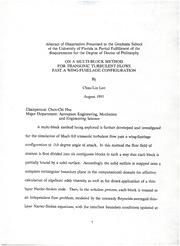Table Of ContentONAMULTI-BLOCKMETHOD
FORTRANSONICTURBULENTFLOWS
PASTAWING-FUSELAGECONFIGURATION
By
CHAU-LINLEE
ADISSERTATIONPRESENTEDTOTHEGRADUATESCHOOL
OFTHEUNIVERSITYOFFLORIDAINPARTIALFULFILLMENT
OFTHEREQUIREMENTSFORTHEDEGREEOF
DOCTOROFPHILOSOPHY
UNIVERSITYOFFLORIDA
1991
ACKNOWLEDGEMENTS
IwishtoexpressmydeepappreciationtoDr.Chen-ChiHsuforhis
constantguidancethroughoutthisresearchandforhisinvaluablehelpinthe
writingofthisdissertation. Also,IwishtothankDr.WeiShyyformakinga
numberofveryconstructivecommentsandsuggestionsduringthecourseofthis
research. Iamalsoindebtedtomembersofmydissertationcommittee,Dr.
UlrichH.Kurzweg,Dr.DavidW.Mikolaitis,andDr.GeraldJ.Micklow,fortheir
interestinthesubjectandvaluablecriticismonthedraftofthisdissertation.
Finally,IwouldliketoextendmyacknowledgementstoDr.Nae-Haur
ShiauandDr.Shu-ChengYangfortheirpreviousworkonthecomputercodeand
plottingpackagesemployedinthisstudyandtoFloridaStateUniversityfor
providingthesupercomputerCrayY-MPresources.
ii
TABLEOFCONTENTS
page
ACKNOWLEDGEMENTS
ii
ABSTRACT v
CHAPTERS
I INTRODUCTION 1
LIBackground 2
1.2LiteratureSurvey 4
L3Objectives 9
L4Overview 9
n FORMULATIONOFPROBLEM
10
2.1DescriptionofProblem 10
2.2NondimensionalizedNavier-StokesEquations 13
2.3TransformedNavier-StokesEquations 16
2.4Thin-LayerNavier-StokesEquations 18
2.5TurbulenceModel 19
2.6BoundaryConditions 23
2.7InitialConditions 24
m NUMERICALMETHODOFSOLUTION 25
3.1GridTopology 26
3.2FlowSolver 32
IV GRIDGENERATION 47
4.1VolumeGridGeneration 49
4.2SurfaceGeneration 55
iii
V RESULTSANDDISCUSSION 67
5.1EffectofSolution-Adaptation 71
5.2EffectofGridRefinement 80
5.3ComplexFlowPhysics 86
VI SUMMARY 92
REFERENCES 95
BIOGRAPfflCALSKETCH 100
'-'•->
. , ' ''
\_ s. * -
t
iv
AbstractofDissertationPresentedtotheGraduateSchool
oftheUniversityofFloridainPartialFulfillmentofthe
RequirementsfortheDegreeofDoctorofPhilosophy
ONAMULTI-BLOCKMETHOD
FORTRANSONICTURBULENTFLOWS
PASTAWING-FUSELAGECONFIGURATION
By
Chau-LinLee
August1991
Chairperson:Chen-ChiHsu
MajorDepartment:AerospaceEngineering,Mechanics
andEngineeringScience
Amulti-blockmethodbeingexploredisfurtherdevelopedandinvestigated
forthesimulationofMach0.8transonicturbulentflowpastawing-fuselage
configurationat-3.0degreeangleofattack. Inthismethodtheflowfieldof
interestisfirstdividedintosixcontiguousblocksinsuchawaythateachblockis
partiallyboundbyasolidsurface. Accordinglythesolidsurfaceismappedontoa
completerectangularboundaryplaneinthecomputationaldomainforeffective
calculationofalgebraiceddyviscosityaswellasfordirectapplicationofathin-
layerNavier-Stokescode. Then,inthesolutionprocess,eachblockistreatedas
anindependentflowproblem,modeledbytheunsteadyReynolds-averagedthin-
layerNavier-Stokesequations,withtheinterfaceboundaryconditionsupdatedat
everytimestep. TheturbulenceclosuremodelemployedistheBaldwin-Lomax
eddyviscositymodel.
Themulti-blockmethodbeinginvestigatedhasadistinctadvantagein
designapplicationinthatalocalchangetotheconfigurationrequiresonlythe
relatedblockgridtoberegenerated. However,theexcessivedistortiononblock
domaintransformation,inparticularthewingblocks,imposedbythespecial
featuresofthemethodmakesitdifficulttogenerategoodblockgridsforaccurate
flowsimulation. Accordingly,specialmeasuresandpropertechniquesforquaUty
blockgriddingshavetobedevelopedandinvestigated.
Inthisstudyaone-dimensionaladaptivegridgenerationtechniquebased
onavariationalapproachhasbeenemployedtogeneratewingsurfacesadaptive
tomeasuredsurfacepressuregradients. Withthesolidsurfaceandthe
correspondingoutersurfacegenerated,thesixblockgridsaregeneratedbyan
algebraicTwo-BoundaryMethodbasedontransfiniteinterpolation. Theblending
functionusedisaHermitepolynomialwhichcanprovidegoodorthogonalgrids
nearthesurface. Also,ahyperbohctangentclusteringfunctionhasbeenusedto
provideeffectivegridpointdistributionandsufficientgridresolutioninthe
viscousboundarylayer. Fortheadaptiveblockgridsgenerated,theJacobianof
transformationevaluatedbyfinite-differenceapproximationsispositiveatevery
gridpoint. Togainfurtherinsightandunderstandingonthemulti-blockmethod
forcomplexflowsimulation,fivedifferentsetsofsixblockgridshavebeen
generatedandinvestigatedforthewing-fuselageflowsimulation. Numerical
vi
resultsobtainedshowthatthemulti-blockmethodinvestigatedisaverypromising
approachwhichcanbefurtherdevelopedforcomplexconfigurationaerodynamics
simulation.
vu
CHAPTERI
INTRODUCTION
Withtheadventofsupercomputersandtheadvancementinsolution
algorithmsfornonlinearproblems,computationalfluiddynamics(CFD)has
becomeapowerfultoolforanalyzingpracticalfluidflowproblems. Eventhough
muchprogresshasbeenmadeinCFD,furtheradvancesareneededinorderto
effectivelyuseitforsimulatinghighspeedturbulentflowspastcomplex
aerodynamicconfigurations. Asuccessfulnumericalsimulationofflowpasta
complexconfigurationrequiresnotonlyanaccurateandrobustflowsolverbut
alsoagoodgridsystem. Inthisstudy,acomputationalmethodutilizingamulti-
blockgridsystemisdevelopedandinvestigatedforsimulatingtransonicturbulent
flowspastawing-fuselageconfiguration.
Webeginthisintroductorychapterwithsomegeneralbackground
informationongridgeneration. Afterwards,aliteraturesurveyisgivenfortopics
relevanttothemulti-blockcomputationalmethodsdevelopedinthisstudy. This
chapterconcludeswithadescriptionoftheobjectivesofthepresentstudyandan
overviewofthisdissertation.
1
2
1.1Background
Gridgenerationisconcernedwiththemappingofunequallydistributed
gridpointsinthespatialdomainontoacomputationaldomainwhereallofthe
gridpointsareuniformlydistributed. MuchoftherapidprogressinCFDcanbe
directlyattributedtothedevelopmentofgridgenerationtechniques,becausethey,
inconjunctionwithmethodssuchasthefinite-differencealgorithm,haveenabled
onetostudyflowproblemsincomplexgeometriesefficientlyandaccurately[1-8].
EisemanandErlebacher[7]classifiedallpossiblegridsystemsthatcanbe
usedbyfinite-differencemethodasfollows: Atthebroadestlevel,agridsystem
canbeclassifiedasstructured,unstructured,ormixeddependinguponhowthe
gridpointsareconnectedtoeachother. Astructuredgridsysteminturncanbe
classifiedasasinglegridoramulti-blockgrid. Asinglegridisonethatisbased
onasingleboundary-fittedcoordinatesystemwhereasamulti-blockgridismade
upoftwoormoresinglegridspatchedtogetherwitheachsinglegridhavinga
differentboundary-fittedcoordinatesystem.
Ofthegridsystemsmentionedabove,theunstructuredandmixedgrid
systemsaremoreversatile,especiallyforcompHcated-shapedspatialdomains;
buttheuseofthesegridsystemswithafinite-differencemethodisstillinastate
ofdevelopment[8,9]. Presently,mostfinite-differencemethodsusethe
structuredgridbecauseofitsinherentcompatibilitywithsuchmethods. Inthis
research,thestructuredgridisused.
3
Methodsforgeneratinggridsystemscanbedividedintotwomajorclasses-
differentialequationmethodsandalgebraicmethods. Differentialequation
methodsgenerategridsystemsbysolvingasystemofpartialdifferentialequations
whichdescribehowgridpointsaretobedistributedwithinthespatialdomain.
Manyofthesemethodsrequireasubstantialamountofcomputationaleffort,
sincethesystemofpartialdifferentialequationsthatmustbesolvedisquasilinear
andoftenascomplicatedasthepartialdifferentialequationsthatgovernthefluid
flowproblem.
Algebraicmethodsgenerategridsystemsbyinterpolatingbetween
boundariesofthespatialdomainandusingstretchingfunctionstocontrolthe
distributionofgridpoints. Here,forthepurposeofgridgeneration,interpolation
meansaprocessofinferringgridpointlocationsbetweenpointswhere
informationisknownexactly. Sincethedesiredgridpointlocationsarean
algebraiccombinationofknownquantities,nopartialdifferentialequationneeds
tobesolvedinthisgridgenerationprocess.
A
"quality"gridsystem,whethergeneratedbydifferentialequationor
algebraicmethods,isusuallyonethatisreasonablyorthogonalandsmoothwith
thegridpointsconcentratedinregionswheretheyaremostneeded. By
strategicallypositioningthegridpoints,thetotalnumberofgridpointsneededto
obtainaccuratesolutionscanbereduced. Thisreducescomputermemoryand
CPUtimerequirements.

